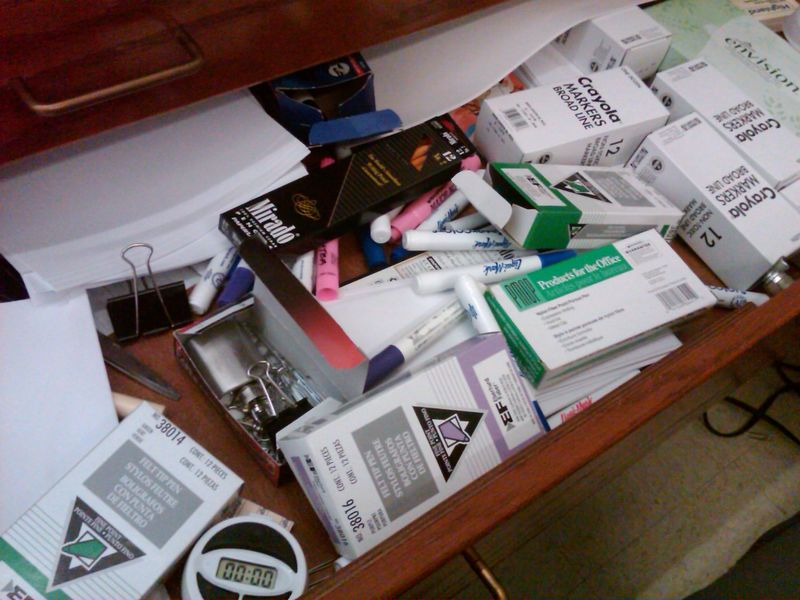At the last district where I worked, each year we were given a $50 budget with which to order classroom supplies such as chalk, paperclips, grading pens, glue sticks, markers… well, you can see how quickly $50 went. To compensate, we relied on our own wallets and the generous help of the privileged population who lived in the district. In fact, perhaps that is why we were able to get by with such a small budget.
In my current school, we have a departmental office with a supply cabinet where we run when we need something. Once the supply cabinet runs dry, there probably won’t be another supply order until the following year. So get what you can, when you can, because that’s all there is, folks.
Although most of us get the supplies we need, it is easy to become an inadvertent hoarder. This year, I’m finding more than last year’s syllabus signature sheets tucked in the back corners of my cabinet drawers. Post-its are especially precious. Yep. Got those. My favorite jumbo paperclips and medium binder clips. Markers that aren’t orange, brown or yellow. Yep, yep, yep. Chalk. Highlighters (pink and green are especially rare and desirable). Scissors. Rolls of tape. Index cards. Staples. Purple felt-tip pens for grading. Those are the best, and they won’t last forever. The list goes on. Supplying my classroom is necessity that becomes a kind of fetish. I currently have three or four drawers of stashes. I didn’t mean to.
On the other hand, why wouldn’t I? And get caught short of small-sized sticky notes when I teach annotation in our novels? No way. My own kids are both in school now, and my own supply budget goes to them. I teach in a less affluent area, and get fewer packs of Crayola markers by begging. I already have to buy printer paper from time to time. It’s recession-time thinking, and I’m looking out for me.
I note an irony: As budgets tighten, more and more dollars worth of supplies get stashed away.
In the traditional high school structure, this supply hoarding, these thousands of dollars of stuff hidden around campus, is an apt metaphor for the hidden caches of professional knowledge boxed into the classroom walls of our school.
The seven period day, with its demands of needs-meeting, transitions, management, documentation, and policy-enforcing transforms even the most generous of us into hoarders. The pressures of time, accountability measures, salary freezes, layoffs and program cuts make us self-protective rather than synergistic. We compete for scarce resources rather than collaborate. We close our classroom doors in survival mode and sneak a few minutes to prepare for our night jobs or our freelance contracts– the extra little somethings that make up for the rising cost of living and the shrinking value of our paychecks which haven’t grown in years. Or, more commonly, we focus on our most intimate sphere of influence: our students and their work. We may live paycheck to paycheck, but most of us do not want to be administrators or real estate agents. We are professional teachers.
When our English department is in a room together, I am deeply amazed at our collective wisdom, expertise, idealism, competence, activism, knowledge and advocacy on behalf of students and families. We are so powerful. We can move the world.
We see each other for 60 minutes. Then we head back to our rooms. We may linger in the hallway, but true collaboration, true tapping into these caches of professional knowledge, takes time and leadership opportunities. This time cannot be easily found outside the bounds of our overwhelming daily obligations.
Admirably, our school has carved out some common planning time to work on student achievement together each week, has given us some autonomy in developing our own agendas for that time. There are guidelines and areas of focus, but so far, and because of our fearless department leader, we have managed to have meaningful conversations about teaching and learning during much of that time.
I know that not all schools handle P.D. this way, and I am grateful that for the last 15 years I’ve been in schools that trusted teachers to lead much of their own P.D. Some of my fondest memories of teaching come from the mornings spent with my Critical Friends Group years back. We learned so much from each other. Those meetings were formative in developing me as a teacher. And I am lucky in my current school’s approach to P.D. But it is not enough.
After attending the Arizona K12 Center’s Teacher Leadership Institute this summer, and learning from the Arizona Teacher Solutions Team, Barnett Berry, and other teacher leaders the possibilities for restructuring schools, I believe that plundering the hoards of teacher professional knowledge will only really happen under a different structure. The school day must be reimagined so that teachers can spend quality time outside the classroom sharing, mentoring, collaborating, leading, while still teaching students on a regular basis (though not with the load they currently carry.) This shift may eliminate assistant principal positions, but it would offer veteran teachers a rewarding, reinvigorating and validating way to continue their career in the classroom while moving the profession forward, and would ultimately lead to better learning for students.
Imagine being that first year teacher who hasn’t made it to the supply cabinet on time and is left with the rotted rubber bands, moldering newsprint and the orange, brown and yellow markers. Wouldn’t you have appreciated it if, instead of high-tailing it back to our rooms with the goods, we had all chosen a favorite office supply that we needed in those first years in the classroom, and had filled a couple of rolly-carts full of those things for you? You might stick around longer, wouldn’t you? And the world would be better for it.








